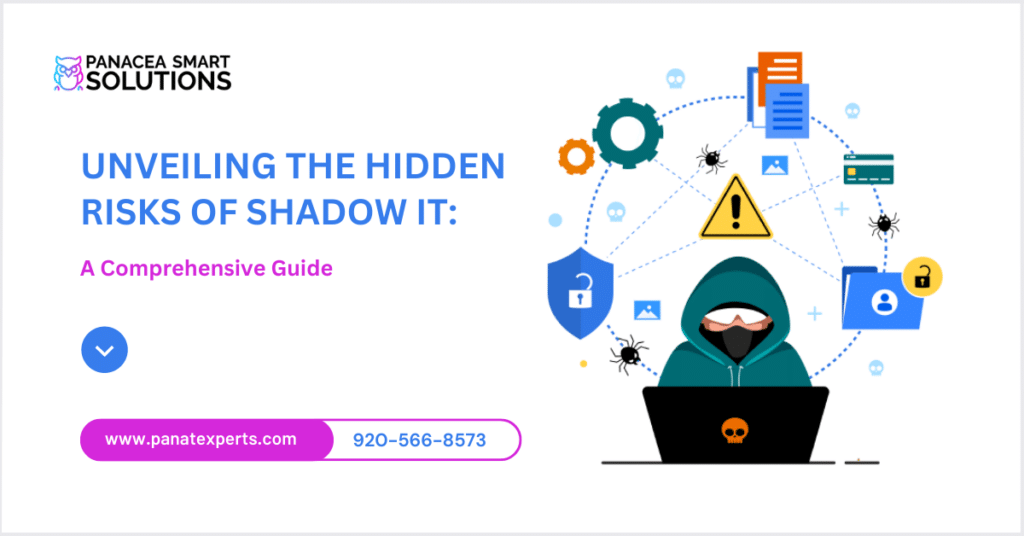In today’s digital era, businesses rely heavily on technology to streamline operations and enhance productivity. However, a growing concern called Shadow IT poses significant risks that cannot be overlooked. In this blog post, we will shed light on the concept of Shadow IT, its potential dangers, and the importance of managed cybersecurity services in combating this hidden menace. Read on to understand how Shadow IT can impact your organization’s security and discover effective strategies to protect your digital infrastructure.
Understanding Shadow IT
Shadow IT refers to the use of unauthorized software, applications, or devices within an organization without the knowledge or approval of the IT department. Employees often resort to Shadow IT to fulfill their specific needs or enhance productivity, bypassing official channels. This practice creates a wide range of challenges and risks, making it crucial to delve deeper into its implications.
Shadow IT typically arises from employees seeking solutions outside the established IT infrastructure. It may involve using personal cloud storage services, collaborating through unauthorized communication tools, or adopting unapproved applications. The allure of Shadow IT lies in its ability to offer quick and convenient solutions for individual employees or departments.
However, Shadow IT can have detrimental consequences. By circumventing official protocols, employees may unknowingly expose the organization to data security vulnerabilities, compliance issues, and a lack of control and visibility over the technology ecosystem.
The Dangers of Shadow IT
1. Data Security Vulnerabilities: Shadow IT introduces unapproved software and devices, leaving critical data and sensitive information susceptible to breaches. This unauthorized use bypasses essential security protocols, increasing the chances of data leaks or cyberattacks. Cybercriminals can exploit vulnerabilities present in unauthorized software or devices, compromising the organization’s overall security posture. Without proper monitoring and control, sensitive information can be exposed, leading to reputational damage and financial losses.
2. Compliance Issues: Organizations are often bound by industry-specific regulations and compliance standards, such as GDPR or HIPAA. The use of unauthorized software or services can lead to severe compliance violations, resulting in legal consequences, fines, or damage to the organization’s reputation. Non-compliance with data protection regulations can have severe financial and operational implications, eroding customer trust and hindering business growth.
3. Lack of Control and Visibility: With Shadow IT, IT departments lose control over the technology ecosystem, making it challenging to monitor and manage security effectively. This lack of visibility increases the chances of undetected security breaches or unauthorized access. IT teams must have oversight and control to ensure a secure and compliant technology environment. Without proper control mechanisms, the organization may be unaware of potential vulnerabilities and fail to implement necessary security measures.
Managed Cybersecurity Services: The Solution to Shadow IT
Implementing managed cybersecurity services is crucial to mitigate the risks associated with Shadow IT. These services provide comprehensive solutions that address the challenges posed by unauthorized technology usage. Here are some key benefits:
1. Proactive Threat Detection and Response: Managed cybersecurity services employ advanced threat detection tools and techniques to identify and respond to potential security incidents promptly. With real-time monitoring, they can identify any unauthorized software or devices, minimizing the impact on your organization’s security posture. Early detection allows for swift action to mitigate risks and prevent potential data breaches. By partnering with managed cybersecurity services providers, organizations gain access to cutting-edge technologies and expertise in threat intelligence, enhancing their ability to proactively protect against emerging threats.
2. Enhanced Data Protection: Managed cybersecurity services help organizations establish robust security measures, including data encryption, access controls, and regular vulnerability assessments. By fortifying the digital infrastructure, these services significantly reduce the risk of data breaches caused by Shadow IT. Protecting sensitive data is essential for maintaining
customer trust and safeguarding the organization’s reputation. Managed cybersecurity services offer a layered approach to data protection, combining technology, processes, and best practices to ensure comprehensive security.
3. Policy and Governance Frameworks: Managed cybersecurity services assist organizations in developing and implementing comprehensive policies and governance frameworks. These frameworks define acceptable technology usage, educate employees about potential risks, and establish guidelines for reporting unauthorized technology usage. By establishing clear policies, organizations can mitigate the risks associated with Shadow IT and promote a culture of cybersecurity awareness. Managed cybersecurity services providers can guide organizations in creating tailored policies and governance frameworks that align with industry standards and regulatory requirements.
4. Employee Education and Awareness: Alongside policy enforcement, managed cybersecurity services offer employee education and awareness programs. These initiatives equip employees with the knowledge and skills necessary to identify and report Shadow IT, reducing the likelihood of unauthorized technology usage. Educated employees become the first line of defense against potential security threats and can play an active role in maintaining a secure technology environment. Through training sessions, workshops, and awareness campaigns, managed cybersecurity services providers empower employees to make informed decisions and take proactive measures to protect organizational assets.
Conclusion
Shadow IT poses significant risks to organizations, compromising data security, compliance, and control. Embracing managed cybersecurity services is essential to mitigate these threats effectively. By leveraging proactive threat detection, enhancing data protection, establishing policy frameworks, and promoting employee education, organizations can tackle Shadow IT head-on. Protecting your digital infrastructure is crucial in today’s evolving threat landscape. Don’t let Shadow IT cast a dark shadow over your organization’s security—take the necessary steps to prevent it and safeguard your business. Partnering with trusted managed cybersecurity services providers will ensure you stay one step ahead of potential threats.
Written By: Dan Ogle, IT Service Manager, Panacea Smart Solutions





